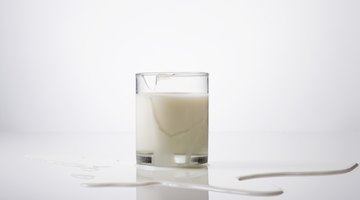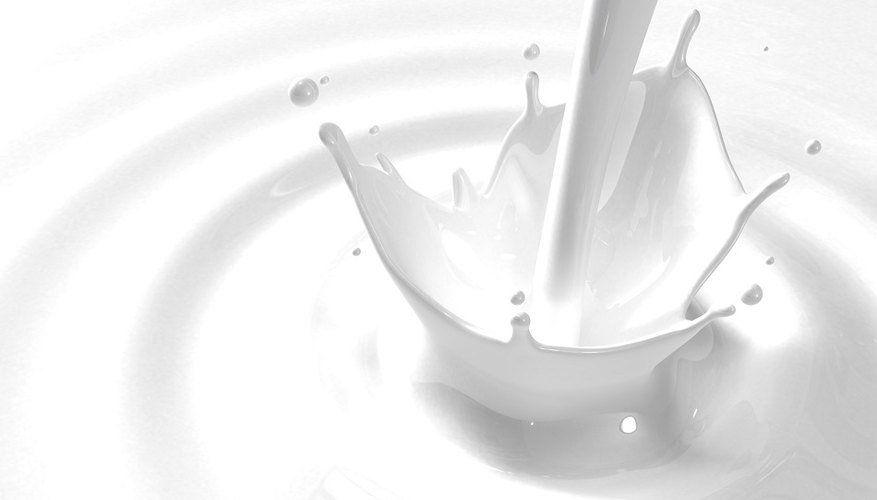Milk provides many essential vitamins required by both children and adults. An 235ml (8-ounce) glass of milk not only supplies the human body with vitamins D and B-12, but also protein, riboflavin, phosphorus and, of course, calcium. In the event of a power outage or of finding a gallon of milk someone has forgotten to replace in the refrigerator, it's important to know the requirements needed to keep milk as fresh as possible.
From the cow to the supermarket

Milk begins its journey straight from the cow at a temperature of about 37.8 degrees Celsius. It is then kept cool in preparation for the pasteurisation process, in which it is heated to a temperature of 63 degrees C (145 degrees F) for a short time, then quickly cooled to about 3 degrees C (38 degrees F). From that point on, milk is kept chilled at that same temperature during packaging and then transportation to supermarket shelves. The entire process takes about two days from udder to supermarket. Each container of milk has been stamped with a "sell by" or "use by" date. Generally, milk is still good for two or three days after the sell-by date.
- Milk begins its journey straight from the cow at a temperature of about 37.8 degrees Celsius.
- Generally, milk is still good for two or three days after the sell-by date.
Refrigeration needs of milk at home

Milk needs to be refrigerated and stored at a temperature between 1.5 and 4.5 degrees C (between 35 and 40 degrees F). Food, including dairy products, that reach temperatures between 5 and 60 degrees C (between 41 and 140 degrees F) (the "danger zone") are potential breeding grounds for salmonella and other coliform bacteria. The general rule of thumb is that milk can stay unrefrigerated for about two hours, but then must be refrigerated as soon as possible after that. In summer, food spoils faster, so it's even more critical to follow the two-hour guideline. If the milk container is still somewhat cool to the touch, it's probably OK.
- Milk needs to be refrigerated and stored at a temperature between 1.5 and 4.5 degrees C (between 35 and 40 degrees F).
- The general rule of thumb is that milk can stay unrefrigerated for about two hours, but then must be refrigerated as soon as possible after that.
Is it spoiled?
Milk that has been exposed to strong light, left out on a counter for more than two hours or frozen and then thawed can develop off-flavours. For every 0.5 degrees C (5 degrees F) over the ideal 4.5-degree C (40 degrees F) refrigeration temperature for milk, its shelf-life is shortened 50 per cent and it quickly loses its pleasant, fresh taste. Containers that appear bloated or swollen, milk with a sour or acidic taste and certainly any milk that appears to have separated or coagulated are all definite signs that milk has gone bad and should be tossed immediately. All milk will spoil eventually, but exposing it to warm temperatures accelerates bacterial growth.
- Milk that has been exposed to strong light, left out on a counter for more than two hours or frozen and then thawed can develop off-flavours.
- Containers that appear bloated or swollen, milk with a sour or acidic taste and certainly any milk that appears to have separated or coagulated are all definite signs that milk has gone bad and should be tossed immediately.
Drinking spoiled milk
Drinking milk that has been left on a counter at room temperature for several hours may or may not make you sick, but drinking potentially bacterial-laden milk isn't worth the gamble. Campylobacter, a bacteria present in spoiled milk, can cause diarrhoea, fever, cramping, vomiting and headaches. When in doubt, pitch any warm milk that's been sitting out on the counter, and make sure baby bottles and toddler "sippy cups" are emptied and cleaned as soon the child is finished with them, or refrigerate any unused portions right away.
Soy, raw milk and shelf-stable milk
As soon as any milk product is opened, whether it's a box of shelf-stable milk, a can of condensed milk, a container of soy milk, or unpasteurised raw milk, the two-hour rule for leaving it unrefrigerated goes into effect. Even though shelf-stable milk can last on the pantry shelf for several months, when it is opened, it is prone to the same bacteria that affects whole or lower-fat milk.
